Queen Cutlery Boxes in 2000’s through 2012 – End of Servotronics Ownership
Dan Lago, Brian Guth, Ashley and Joe Mick, David Krauss, and Fred Fisher
Queen Cutlery Boxes
D2 steel was introduced in 2002, with the block “Queen Cutlery Co,” a #model number and “Tool Steel” etch on the blade and tang stamp with “PH-D2” {Peters Hardening-D2} (see figure 1). The knife boxes also were re-designed to highlight the use of D2 steel. While other steels were used occasionally, D2 became the primary steel for the company and most cataloged knives were produced in that steel, so the blueish and green labels showing “tool steel” (and occasionally black “Tool steel” labels) were widely seen after 2002.
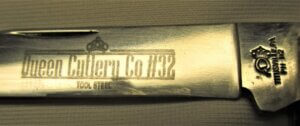
Figure 1. Blade etch (Company name. model #, and “Tool Steel”) and tang stamp at the beginning of the 21st century. The company’s move to D2 Steel was also reflected in box changes after 2002. © Dan Lago.
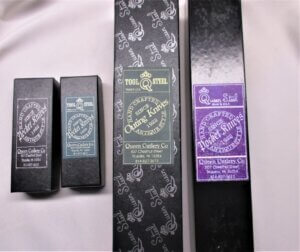
Figure 2. Four versions of Queen-labeled knife boxes in the 2000’s – two larger fixed blade boxes and two for pocket knives. Although never officially communicated by Queen, it appears that the labels reflect the steels used in the knife contained in the box: black for carbon, blue or green for D2 tool steel, and purple for stainless steel (usually 420). © Dan Lago.
In Figure 2, the D2 (Tool Steel) labels show a slight difference for “pocket” or fixed blade or “Outing knives.” The purple stainless label was used as available, since it is very unlikely a pocket knife was enclosed in such a large box (no label to identify it as a letter opener). File and Wire Tested series knives, which began in 1998, used ATS34 steel for master blades at least through 2016. ATS34 was also intermittently used on some Schatt & Morgan and Robeson brands, but not on any Queen-labeled knives, to our knowledge.
While most Queen boxes were black, some glossy and some textured, it can be seen that older boxes on hand from the 1990s were also used (Figure 2 shows a ‘90s black “Q knife Queen Steel” box). They were after all still a company that sold knives that needed boxes with a label, so whatever was on hand was used, especially for most Queen-marked knives. It appears that the company did not always pay the kind of attention to individual box specifics that now might be of interest to collectors.
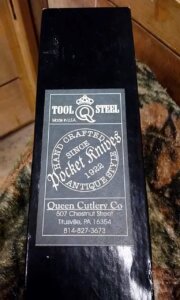
Figure 3. A black “tool steel” label (used infrequently) on a 4185 premium saber knife – also demonstrating that “pocket knives” labels were used on fixed blades. © Brian Guth.
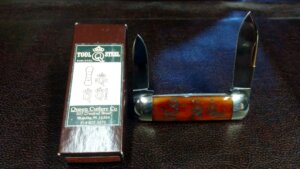
Figure 4. Dan Burke Baby Sunfish smooth orange bone with engraved historical tang stamps on the handle and a deep brown box with a unique label showing the same historical tang stamps, 2010, edition of 500, © Brian Guth.
Schatt & Morgan Boxes
Queen continued to use the deep brown two-piece box with traditional Schatt & Morgan label until the company’s 2018 bankruptcy (Figure 5.) Some older boxes show a light tan label and a somewhat larger size on the box. Some of the newer labels show a whiter background and smaller size than the top – more adhesive “stick-on” rather than thinner and glued.
These boxes have been available on the secondary market since the first year of the Keystone Series in 1991, so care must be used to check if the knife matches the markings of its box. Many boxes show handwritten comments over top of the factory labels as any available box was pressed into service to complete a sale on the secondary market. Additionally, because some Queen product was sold from the Company Store, the buyer might get an unmarked Schatt & Morgan box that had just been pulled from the shipping department inventory. Queen was at times lax in marking their boxes, even after more than a decade of experience with avid collectors, so be prepared to find variations (This has happened to several authors of this article).

Figure 5. The most common Schatt & Morgan box, used from 1991 through 2010. The box on the left has a thicker label with adhesive backing, while the box on the right has a thinner glued label with the more traditional eggshell color. © Dan Lago.
In the early 2000s, Queen offered a series of carefully boxed “Presidential” knives, selected by the company President in editions of 400. These knives were finely finished and included high quality handles (pearl for most) and deep gold etches. Initially these knives were provided in a black clamshell boxes (Figure 6) and subsequently in small walnut boxes (Figure 7). This set included a large traditional clock to entice collectors (see Figure 8).
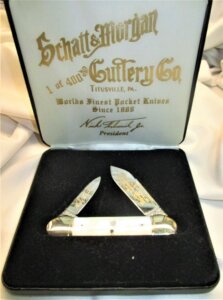
Figure 6. First knife in President’s series, a pearl handled canoe in black clamshell box. © Dan Lago.
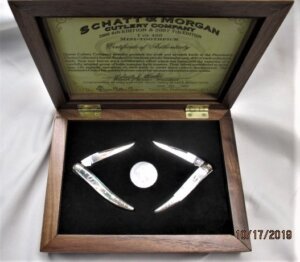
Figure 7. 2006 and 2007, small toothpick knives in Mother of Pearl and Black Lipped Pearl, with contrasting inlay of initials for both Schatt & Morgan in opposing knives in Walnut box, in an edition of 400. All the text within these President’s Choice display boxes permanently identified the knife enclosed. © Dan Lago.
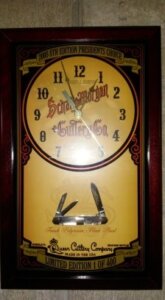
Figure 8. 2005 President’s knife – A banded French Polynesian Black Pearl whittler with a large clock. © Brian Guth.
Dedicated, wooden display boxes for individual Keystone series sets were not shown in sales fliers until 2000, the tenth year of the series. From 2001, until the series ended in 2010 the yearly display case was listed as “Free Display case” (only if the entire yearly set was purchased however), and only occasionally shown with the kind of wood the case was constructed with (Cherry or Walnut). The display cases were also listed separately for purchase in sales fliers that included the pricelist for each knife in the yearly series in 2004 and 2005. From 2006 to 2010, a price was not given for the display box, only the 10% discount for the purchase of the entire set which also qualified for a free display case. So theoretically display cases could, at times but not always, have been purchased. Its unknown how often this happened.
The 2003 display seen below used walnut wood and the case is unique in having bright red “keystone” and date painted on the glass in a way that makes it a perpendicular display for the knife set, (Figure 9). All the other Keystone series display cases were produced to display knives in a more traditional horizontal manner that made it easier to show the knives with the blades open.
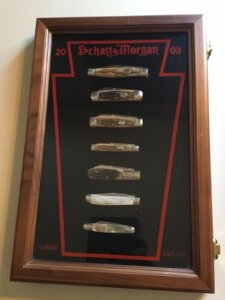
Figure 9. Unique Walnut display case for the 2003 Schatt & Morgan Keystone set. Also, the only display that shows knives in “blade closed.”
The next three years of the Keystone set boxes (2004-2006) are shown in more detail here because in our opinion, they represent the high-water mark of the series. The display cases were labeled with the year and company name as in Figure 10. and used cherry wood in 2004. Additionally, every cardboard knife box associated with each of those three yearly sets had a label with a unique image on it specific to the knife inside. (Figures 11 through 16). During these three years the boxes were essentially individualized, and the labels contained lots of useful information. For example, see the 2004 Yankee Muskrat and box illustrated below (Figure 12). The label gives the name of the knife, the factory pattern number, the quantity made, the purpose, and an interesting fact, i.e., “The Original Single Backspring”. A lot of thought went into that design and to the design for each of the other boxes from that year. And variations on design themes followed for the next two years.
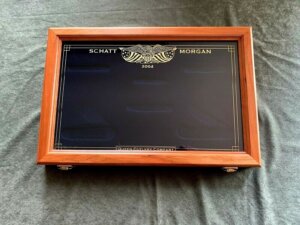
Figure 10. Cherry Wood 2004 Keystone display box. © David Krauss
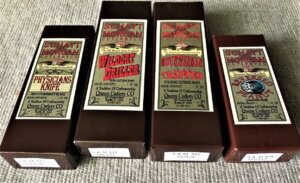
Figure 11. 2004 boxes for the knives included in the 14th edition of the Keystone Series. That year the knives also featured sterling silver Keystone shields. © David Krauss
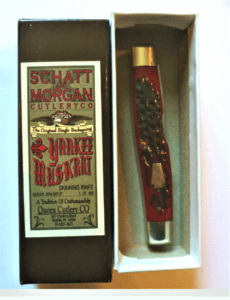
Figure 12. Here is a hard-to-find example of a Yankee muskrat in the original box. In 2004 each series XIV box label identifies the specific knife in the box, providing details of the knife that in our opinion adds to the pleasure of owning it.
© Brian Guth

Figure 13. 2005, 15th Keystone Series, box labels with “dollar” design with the proverbial (tongue in cheek) “Buck”(two bucks on the railsplitter) in the center oval, for the five stag handled knives in the set and a special blue label for the exotic Black lipped pearl Mini toothpick. © David Krauss
Again, in 2005 each box label identifies the knife inside and provides other useful information. For example, in addition to showing the knife’s name and the series year, the numbers in the four corners of the “currency” are Queen pattern and model numbers for that particular knife. The company’s phone number is also part of the graphic presentation – clever and fun. Most of the time the model number can be found on the end of each box in the various sets of the Keystone Series and it was also the case for these knives (Figure 14).
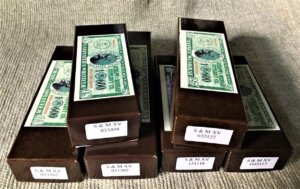
Figure 14. 2005, 15th Keystone Series, Box end labels. © David Krauss.
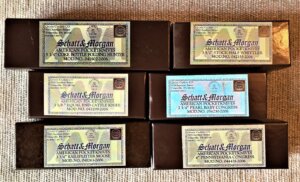
Figure 15. 2006, 16th (XVI) Keystone Set Box tops, again with different color for the exotic Pearl baby Congress. © David Krauss.
Figures 15 and 16 show the 2006 series boxes. The set used an innovative “envelope” labels. The main address identifies the Schatt & Morgan knife inside by name, model number and length of the closed knife. The outer edges of the envelope repeat the words “Bradford Green Bone” that was used for the handle material. Close observation reveals an “XVI” background is used on all boxes for the year. The return address shows the factory address in Titusville PA, with the S & M logo as the stamp, and the post mark is for Gowanda, NY, in 1902, the year that Schatt & Morgan moved their factory from Gowanda to set up their business in Titusville. Finally, in the middle of the post mark, with close observation, one finds the initials for both Schatt and Morgan.
These boxes are another example of just how much thought, time, and effort went into the creation of the Schatt & Morgan labels for those 3 years.
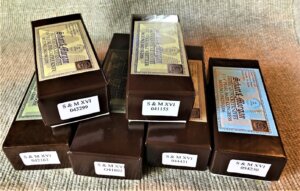
Figure 16. 2006, 16th Keystone Set Box End labels. © David Krauss.
It seems very clear to us, that these fully intact Keystone sets with their proper boxes and display case would provide their owners with a collection of special knives. Because many individual knives are often re-sold on the secondary market, boxes and knives are easily separated. Its easy to understand that the correct knife box was often not as important to the collector who had their eye on a specific knife: especially since the twenty year series only had year-specific, box-labeled knife boxes for those three years. Its likely that the relative rarity of these knife sets, “complete” with the proper boxes and display case will have increasing collector value. And for some the combination of the knife with the correct box provides a strong provenance that the knife is “right”.
Queen Cutlery did not continue this innovative and creative strategy in the final four years of the Keystone Series. They returned to standard brown boxes and traditional Schatt & Morgan labels, although they did continue to identify display cases with painted or etched glass and small brass labels at the bottom of the box.
William “Bill” Howard is among other things, a cutler who wore several hats at Queen at that time, and he was deeply involved in designing and creating the yearly Keystone series. He is also responsible for the graphics on the XIV-XVI labels. Bill left Queen Cutlery Company on July 31st in 2006 and immediately founded Great Eastern Cutlery (GEC) on August 1st of 2006. We admire both his vision and his skillful creation of such interesting knife labels over those three years, (and of course, the Keystone series knives themselves!). These graphically complex labels were different each year, executed in a very creative and often humorous way; they are something that can be appreciated on their own, and they give collectors some value added to their knives.
Bill Howard has consistently used the model of developing interesting labels, knife and bone handle names, along with top-quality packaging in building the success of his current company. This looks like the orientation that we believe was already a part of the way he wanted to run a business when he left Queen. The Schatt & Morgan box labels Bill produced for Keystone series of 2004-2006 were special; creative, nostalgic and playful. To that end we must add that in addition to creating high quality cutlery Bill Howard thought and continues to think “outside the box.”
The Special Factory Orders (SFO) from Clarence Risner Cutlery for his highly regarded Schatt & Morgan “Premier ” series was also initiated and completed in early part of the 21st century. The Queen factory produced two knife patterns per year for a total of ten unusual knives (see Lago & Jackson, 2020). His knives were shipped initially in black boxes and later in blue cardboard boxes that showed a (Gowanda) New York factory image (Figures 17 and 18). The graphics on the boxes are wonderful, fanciful nostalgia. The very high quality Premier series knives used a S&M New York tang stamp, and a special S & M shield (Figures 17 and 18). The box’s labels displayed the year of release, model number, and almost always, the number of knives produced. These boxes seem especially difficult to find on the secondary market, probably because so many owners prefer to simply display the knives. Indeed, it is hard work to keep track of the box that matches its original content if that knife is not stored in the original box.
It should be noted that reproduction of the actual Gowanda New York factory that Schatt & Morgan had on their letterhead at the time was pure fantasy. The actual factory was a two story building probably significantly less than 1/5 of the size of the factory the graphic portrayed; a practice not uncommon in those days. Additionally the “New York Cutlery Company” was only used in the very early days of the company’s short stay in Gowanda New York.

Figure 17. Four boxes from the Premier Series identifying the year, model number, and edition of each individual knife on three of the four boxes. © David Krauss

Figure 18. A Premier Schatt & Morgan Knife and Box, 2008. With a very difficult to produce lockback humpbacked whittler. The shield incorporates both the Schatt & Morgan logo and the word “Premier”. Deep brown jigged bone, and a New York tang stamp. The box uses old images of the “factory” and shows individualized description of the knife inside. © David Krauss
Note: information regarding the year of release, the model number and the number of knives produced found within the top rectangle of the Premier label.
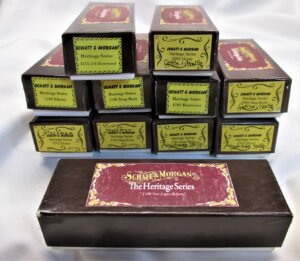 Figure 19. Boxes for the two years of the Heritage Series, 2011 and 2012. © Dan Lago
Figure 19. Boxes for the two years of the Heritage Series, 2011 and 2012. © Dan Lago
In 2011 Queen initiated the “Heritage” Series. With satin finished carbon steel blades with long pulls, Norway iron bolsters, and handled mostly in wood, they were made to as look identical as possible to the original working man knives Schatt & Morgan made over 100 years before. The patterns chosen matched those found on pages of an early 1900 Schatt & Morgan catalog (a facsimile catalog and display case was included if the entire set was purchased). This series had been meticulously researched by well known cutlery collector and historical cutlery researcher David Clark, who had for several years consulted with Queen and had become their official company Historian. Following immediately on the heels of the twenty yearlong Keystone series of fancy “collector grade” knives, these wonderfully plain knives were not as well accepted as the long-running Keystone series had been. As “authentic” and true to the originals as they were, the series only lasted two years and the series’ second release appeared to fizzle out for a number of reasons; ranging from lack luster company support and little promotion, to problems with constructing the knives themselves. It’s disappointing that such a good idea was not well executed.
This short lived series used the familiar S & M brown box, with a smaller label showing a perimeter scroll in yellow (Figure 19). The boxes also had yellow end-labels and each year of the release had a different type of scroll work on the end label. Those labels described the model number and handle material of the knife. Since most are not familiar with the antique model numbers of these knives, some labels contained handwritten names on them. Later, still under Daniels ownership, a number of non-series Heritage Series knives were made by the company from excess materials and blades marked with the Gowanda tang stamp; for example a smooth white bone gunstock knife was produced. These knives were not part of the vision for the Heritage series and they used different boxes.
One wonders if the change in the quality of some knives coming out of the Queen factory during those years may have contributed to Servotronics decision to sell the company to Daniels Family Knives in 2012.
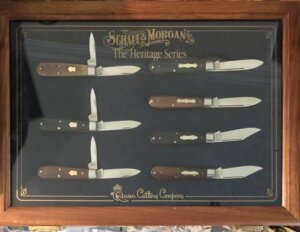
Figure 20. 2011, first year of the Heritage Set, which replaced the twenty-year run of the Keystone Series. Both 2011 and 2012 used Walnut display boxes.
This effort is a first edition and we welcome additional items that you think should be included in this busy decade of Queen Cutlery’s work. Thank you.
Reference
Lago, D. and Austin Jackson, (2020). https://secureservercdn.net/198.71.233.109/gbh.929.myftpupload.com/wp-content/uploads/2020/02/Clarence-Risner-1-2020.pdf

![figure 2[21] Four versions of Queen-labeled knife boxes in the 2000's](https://queencutleryguide.com/wp-content/uploads/elementor/thumbs/figure-221-q077gnqizoh945ycn14qt7s4bqg8x6j2aywq8a5p54.jpg)

